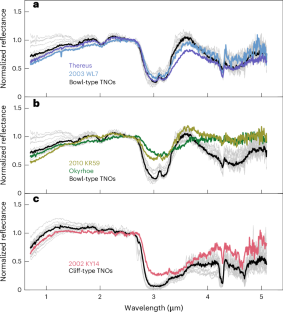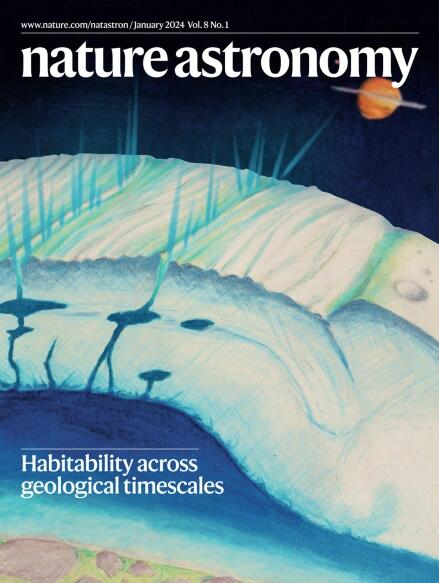Thermal evolution of trans-Neptunian objects through observations of Centaurs with JWST
IF 12.9
1区 物理与天体物理
Q1 ASTRONOMY & ASTROPHYSICS
引用次数: 0
Abstract
Centaurs are small bodies orbiting between Jupiter and Neptune and behave as an intermediate population between trans-Neptunian-belt objects and Jupiter-family comets. As such, their surface composition and evolutionary processes are key to understanding the Solar System’s history. However, the mechanisms driving their transformation and the impact of thermal processing on their surfaces remain open questions. Here we examined the surface properties of five Centaurs using the James Webb Space Telescope near-infrared spectrograph reflectance spectra (0.6–5.3 μm). They exhibit considerable diversity in surface composition. Our analysis indicates that Centaurs can be split into two main categories, which is also observed for trans-Neptunian objects: one group has surfaces composed of refractory materials with some water ice, whereas the other is dominated by carbon-based materials. Additionally, two of the five objects have primarily refractory surfaces with minimal volatiles, suggesting a high concentration of primitive, comet-like dust. We suggest that the observed Centaur surfaces reflect their transitional states, as they are shifting from being ice-rich bodies to progressively becoming more dominated by non-volatile materials as they approach the Sun. Such thermal processing may have changed the surface properties of other similar Solar System bodies, like comets, Jupiter trojans and D-type asteroids. JWST/NIRSpec spectra are used to analyse the surfaces of Centaurs, revealing two main compositions: those with refractory materials and water ice and those rich in carbon-based materials. Strong surface weathering due to thermal processing may be responsible.


通过JWST对半人马的观测,海王星外天体的热演化
半人马座是在木星和海王星之间绕轨道运行的小天体,它的行为就像跨海王星带天体和木星家族彗星之间的中间种群。因此,它们的表面组成和进化过程是了解太阳系历史的关键。然而,驱动其转变的机制以及热加工对其表面的影响仍然是一个悬而未决的问题。本文利用詹姆斯·韦伯太空望远镜近红外光谱(0.6-5.3 μm)研究了5颗半人马座行星的表面特性。它们在表面组成上表现出相当大的多样性。我们的分析表明,半人马座可以分为两大类,这在海王星外的天体中也可以观察到:一类表面由耐火材料和一些水冰组成,而另一类则主要由碳基材料组成。此外,五个天体中有两个具有基本难熔的表面,挥发物很少,这表明存在高浓度的原始彗星状尘埃。我们认为,观测到的半人马座表面反映了它们的过渡状态,因为它们在接近太阳的过程中,从富含冰的天体逐渐转变为由非挥发性物质主导的天体。这样的热处理过程可能已经改变了其他类似太阳系天体的表面特性,比如彗星、木星木马和d型小行星。
本文章由计算机程序翻译,如有差异,请以英文原文为准。
求助全文
约1分钟内获得全文
求助全文
来源期刊

Nature Astronomy
Physics and Astronomy-Astronomy and Astrophysics
CiteScore
19.50
自引率
2.80%
发文量
252
期刊介绍:
Nature Astronomy, the oldest science, has played a significant role in the history of Nature. Throughout the years, pioneering discoveries such as the first quasar, exoplanet, and understanding of spiral nebulae have been reported in the journal. With the introduction of Nature Astronomy, the field now receives expanded coverage, welcoming research in astronomy, astrophysics, and planetary science. The primary objective is to encourage closer collaboration among researchers in these related areas.
Similar to other journals under the Nature brand, Nature Astronomy boasts a devoted team of professional editors, ensuring fairness and rigorous peer-review processes. The journal maintains high standards in copy-editing and production, ensuring timely publication and editorial independence.
In addition to original research, Nature Astronomy publishes a wide range of content, including Comments, Reviews, News and Views, Features, and Correspondence. This diverse collection covers various disciplines within astronomy and includes contributions from a diverse range of voices.
 求助内容:
求助内容: 应助结果提醒方式:
应助结果提醒方式:


